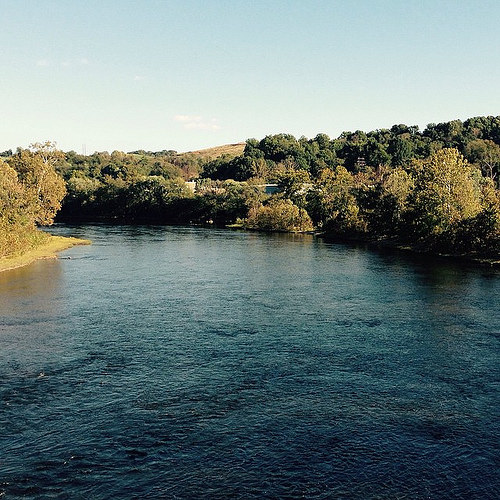May 31, 2016
Lynchburg got in the news lately on account of Liberty University suing neighbors over unwanted lake. People know about Liberty University (“LU”) from the political-incorrectness of its leaders, especially Jerry Falwell, Sr. Long before Donald Trump captured the headlines with controversial statements, Mr. Falwell had a comparable relationship with the news media. Liberty brands itself as a conservative Christian University. Until recently, I had no idea how intermeshed Liberty is in Lynchburg, Virginia. For example, in March 2016, Liberty purchased a 75% interest in the River Ridge Mall for $33.5 million dollars. This mall is across the street from LU. According to ABC13 WSET, Liberty will allow the property managers to operate the mall without much regard for the political or religious viewpoints of the University. R-rated movies will be shown. Victoria’s Secret will remain open. President Falwell, Jr. explained that the University purchased the controlling interest in the mall to diversify its investment portfolio.
River Ridge Mall is not the only local off-campus real estate owned by LU. Many years ago, a Real Estate Investment Trust donated Ivy Lake to Liberty University. Ivy Lake is the centerpiece of a residential development 10 miles from the LU campus. Ivy Hill Recreation, LLC (“IHR”), a LU subsidiary holding company and the homeowners around the lake are in an intractable dispute over maintenance of the lake’s dam and the road that runs over it. In April, 2016, IHR brought a lawsuit against more than 400 landowners, seeking contribution towards necessary repairs to the dam and the roadway. This case tests the institutional values of LU regarding respect for property rights and neighborly obligations. The case also illustrates risks to landowners when the duties to maintain and repair roads and bridges in a community are not very well-defined. Most suburban properties without direct access to public right of ways have recorded HOA covenants that refer to roads as commons areas. When considering purchase of properties in a HOA, potential buyers certainly should carefully review and consider the HOA disclosure documents. As this lawsuit shows, sometimes home buyers should be equally skeptical about the absence of restrictive covenants when there are “common areas” that require maintenance.
This case captured my attention because I grew up a mile from a man-made lake in rural Virginia. While the lake and adjoining park are owned by the local government, some of our neighbors had lakefront properties. My brothers and I used to walk to the lake during the winter and sled down the side of the dam. One winter, someone built a sledding ramp near the bottom of the dam for cheap, risky thrills. In the summer, I would run up the side of the dam for an intense workout. Perhaps IHR could offer rights to use a beach area on the lake as an incentive to maintain the dam?
According to the lawsuit, the developer constructed a dam across ivy creek in order to create Lake Ivy. The lake adds scenic and recreational value to adjoining owners. The developer built a road across the dam. Some of the homes around the lake are only accessible by the road across the dam. The lakefront owners have easements to use the lake for recreational purposes. What is unusual here is that the lake, dam and road are not owned by the county or by an HOA. The developer donated the Lake to Liberty University, subject to the easements of the homeowners. Liberty faculty, students and staff rarely use the lake. A few years ago the Commonwealth of Virginia determined that per statute, the dam required extensive repairs, particularly the spillway and the road over the dam. If the spillway and road are not repaired, they must be closed to mitigate risks of failure. The repairs will cost approximately $1 million dollars. The state ordered IHR to comply with the safety requirements. Because of all of this, Liberty is no longer interested in owning the lake property. If they can’t get the owners to assume ownership of the property, they at least want them to contribute to the repairs.
This dispute is complicated by the fact that some defendant owners have lakefront acreage and don’t use the dam road, some rely upon the road over the dam (with no lakefront), and some are on the water and rely upon the dam road for access.
The neighborhoods surrounding the lake are not without any restrictive covenants. While they don’t all appear to be an HOA, most of them are subject to a declaration of agreements that restricts development to residential use, sets up an architectural committee, prohibits commercial uses, limits unsightly outbuildings, and other restrictions.
The gravamen of LU’s demands to the homeowners is not unreasonable. If the owners want to continue to enjoy access to their properties, someone needs to maintain the dam road. If the waterfront owners want to continue to enjoy the lake, someone needs to support the repairs to the spillway. Many landowners willingly signed documentation that would require them to make pro-rata contributions to the repairs. LU would prefer to have the owners form a HOA with the lake property as a common area. The lawsuit doesn’t request that the owners be forced into a formal HOA. Judges have discretion to craft solutions to easement disputes. However, they cannot decree creation of an HOA. HOAs must be set up by the developer beforehand, because rarely will owners unanimously consent to one. Enough oppose the efforts to require filing of the lawsuit. LU’s decision to file the lawsuit is more reasonable than unilaterally draining the lake and eliminating the dam without an effort to resolve the dispute. Without the lake, the owners will lose a perk. Without the roadway, their properties become useless because of lack of access.
The lawsuit suggests that the legal and practical aspects of all of this has been apparent for many years. Any potential buyer could research land records and determine that if the dam road required repairs, someone would have to pay for it. Also, the developer who built the lake apparently did it on the cheap. The lawsuit alleges that, “The work necessary to armor or harden the spillway was contemplated when the dam was originally conducted, however it apparently was not completed, and it must be done now as a condition of maintaining the dam.”
What is LU asking the Court to do for them? The lawsuit contains five claims:
Count 1: Duty to Maintain Easement (both the lake and the required repairs)
Count 2: Contribution (to IHR towards Required Repairs and other related issues)
Count 3: Right to Assess a Fee (for use of the lake, consistent with the right to makes rules & regulations)
Count 4: Negative Reciprocal Easement (lake development parcels have similar restrictions, most have express easements for recreational use of lake subject to rules and regulations, because they have easements for use, they should be bound by the rules and regulations, and also should be bound to contribute to the required repairs)
Count 5: Otherwise, owners must (1) personally make the repairs or (2) suffer the consequences of an abandoned easement.
In my opinion, IHR is overreaching somewhat in this lawsuit. I doubt that the judge would enter an order that would create a quasi-HOA relationship between the parties absent a unanimous agreement. The lawsuit burdens the owners with having to defend the case. It forces them to take a position, either participate in the maintenance and repairs or abandone their interest in the road, dam and lake. I would be very surprised if the judge would do more than deciding that the LU subsidiary is entitled to financial contribution for the minimum amount of repairs to maintain the easements.
Regardless of its outcome, this case has lessons learned for prospective property owners. Buyers should not assume that the developer will record covenants that will adequately address common area maintenance. If a developer wants to give away a property like a man-made lake that is unfinished and requires maintenance, then an institution like a University should consider the implications before accepting the gift. Hopefully these parties can resolve this dispute and avoid endless litigation and/or removal of the dam. Ivy Lake could remain a blessing, and not become a curse.
photo credit: The James River from the Old N & W Railroad Bridge via photopin (license)(does not depict creek or lake in article)


